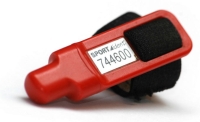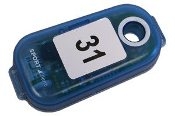SportIdent Epunch Info
The electronic timing system used by QOC (and many other races worldwide) is made by SportIdent. The basic configuration consists of a start box, multiple control/checkpoint boxes, and a finish box; each competitor has a small "epunch" (aka dibber or finger stick) that is placed in or near each box to record time. You may rent an epunch at our events or use your own; a group of people orienteering together only need one epunch for their group.
The great thing about timing chips is the ability to record exactly when you visited various checkpoints, and once you've finished and downloaded your data, you get a printout showing all your intermediate times as well as your total time. [Compare this to others at the event or online afterwards to see where you were faster or made better route choices.] From the club's point of view, electronic timing streamlines registration and allows for safety checks - like who went out onto a course but hasn't come back yet - which also means please always remember to check back in at the download station when you're done orienteering, regardless of how many controls you found.
Epunch FAQs
Where can I buy an epunch?
QOC recommends purchasing an epunch from:
Scarborough Orienteering: SI Page is here
Our epunch guru, Valerie Meyer, suggests getting the SI-9, unless you're a person who is planning to compete internationally (in which case the SIAC may be appropriate).
What's the difference between the SI-8 and SI-9?
There are two main differences between dibbers: the maximum number of punches (controls), and the speed with which the punch is timestamped.
The SI-8 dibber is a finger stick, holding a maximum of 30 controls, and therefore suitable for most orienteering courses including longer advanced ones. In use, the SI-8 is generally worn on a finger, and is inserted inside the opening of an epunch timing unit. This dibber is used by almost all QOC orienteers and is the type loaned out at club events.
The SI-9 dibbers are like the SI-8 in most respects, except that the SI-9 holds up to 50 controls.
These two types record time splits equally fast (115 milliseconds), and both trigger a visual (light) and auditory (beep) cue when properly positioned in or near an epunch timing unit.
 SI-8 SI-8 |
How do I use one of these at an event?
Once you have an epunch (your own or one borrowed as part of your registration fee), you should place it in or near the Clear box (to erase old data) and then place it in or near the Check box (to confirm that it's ready to accept new data). Always listen for the beep and watch for the red flash of light to ensure the connection was made between your punch and each box.
 Proceed to the start area - and make sure to place your epunch in or near the Start control box (triggering a beep and flash). Your time has started; proceed around your orienteering course, making sure to place your epunch in or near each checkpoint/control box on your course. [Both the orange and white flag/bag and the control box should be numbered - always check that it's the right number!] At the Finish area, make sure to place your epunch in or near the Finish control box - which 'stops the clock'. FYI, the boxes QOC uses are generally a bit larger and are black compared to the one in the photo.
Proceed to the start area - and make sure to place your epunch in or near the Start control box (triggering a beep and flash). Your time has started; proceed around your orienteering course, making sure to place your epunch in or near each checkpoint/control box on your course. [Both the orange and white flag/bag and the control box should be numbered - always check that it's the right number!] At the Finish area, make sure to place your epunch in or near the Finish control box - which 'stops the clock'. FYI, the boxes QOC uses are generally a bit larger and are black compared to the one in the photo.
Then, catch your breath, and head over to the download station to check back in, get your printout of split and total times, and if your epunch is a borrowed one, turn it back in. Stare at your results printout, compare it to others, and start looking forward to your next chance to go orienteering, perhaps while snacking on the post-race refreshments.
Does it matter if I put it in a control box that wasn't the next one I was supposed to find?
On a traditional orienteering course where you are supposed to find the controls in a certain sequence, it doesn't matter if you find (and epunch) an incorrect control box, or even one later in sequence on your own course than the one you were looking for, AS LONG AS you go and find the one you were supposed to find, AND, you then continue to find your other ones in order (including revisiting any you accidentally found out of sequence earlier). Your epunch must have sufficient capacity to remember all your splits, though.
What happens if a control box out on my course doesn't beep or flash?
First, make sure you've held your epunch in the unit long enough. If it still isn't beeping or flashing, it might be malfunctioning. This is rare, but can happen. In that case, use the pin punch (the reddish plastic thing that looks a little like a small stapler, hanging from the nearby orange and white flag) to punch a pattern into your map and map case. That will prove you were at that location (since the pin punch patterns are unique). Make sure to tell the volunteers at the download station that this happened when you check back in after finishing your course.
Is there a comparison of all SI-card types, in terms of their speed, capacity, serial # range, and the like?
Sure - take a look at either this file for the newer cards (SI-8 and up) or this file for older cards.
